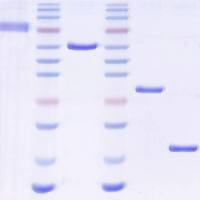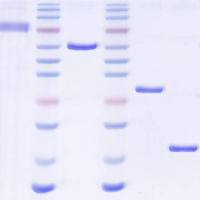【分享】氨基酸结构及名称表(PDF)
丁香园论坛
2951
虽然20个标准氨基酸的结构、名称和简写表示随处可见,但是我一直没有找到一份满意的。
而且很多是网页形式的,想打印出来随时参考时,还得编辑一下,比较繁琐。
这次提供的pdf文档,是直接编辑好的,可以直接打印参考,而且只有1页。
最难得的是,文档中对氨基酸的性质和分类做的很好,而且有很精到的注解。
就用这个做参考吧!
http://www.accessexcellence.org/RC/VL/GG/garland_PDFs/Panel_2.05b.pdf
Acidic amino acids are polar and negatively charged at physiological pH. Both acidic amino acids have a second carboxyl group.
Amides are polar and uncharged, and not ionizable. All are very hydrophilic.
Aliphatic R groups are nonpolar and hydrophobic. Hydrophobicity increases with increasing number of C atoms in the hydrocarbon chain. Although these amino acids prefer to remain inside protein molecules, alanine and glycine are ambivalent, meaning that they can be inside or outside the protein molecule. Glycine has such a small side chain that it does not have much effect on the hydrophobic interactions.
Aromatic amino acids are relatively nonpolar. To different degrees, all aromatic amino acids absorb ultraviolet light. Tyrosine and tryptophan absorb more than do phenylalanine; tryptophan is responsible for most of the absorbance of ultraviolet light (ca. 280 nm) by proteins. Tyrosine is the only one of the aromatic amino acids with an ionizable side chain. Tyrosine is one of three hydroxyl containing amino acids.
Proline is the only cyclic amino acid. It is nonpolar and shares many properties with the aliphatic group.
Basic amino acids are polar and positively charged at pH values below their pKa's, and are very hydrophilic. Even though the basic amino acids are almost always in contact with the solvent, the side chain of lysine has a marked hydrocarbon character, so it is often found NEAR the surface, with the amino group of the side chain in contact with solvent. Note that in the drawing, histidine is shown in the protonated form, while at pH 7.0, the imidazole would exist predominantly in the neutral form.
Proline is one of the ambivalent amino acids, meaning that it can be inside or outside of a protein molecule. Due to its unique structure, proline occurs in proteins frequently in turns or bends, which are often on the surface. The structure shown is of the amino acid in the ionization state that predominates at pH 7.0.
Hydroxyl amino acids are polar, uncharged at physiological pH, and hydrophilic. The phenolic hydroxyl ionizes with a pKa of 10 to yield the phenolate anion. The hydroxyl groups of serine and threonine are so high that they are generally regarded as nonionizing.
The sulfur-containing amino acids (cysteine and methionine) are generally considered to be nonpolar and hydrophobic. In fact, methionine is one of the most hydrophobic amino acids and is almost always found on the interior of proteins. Cysteine on the other hand does ionize to yield the thiolate anion. Even so, it is uncommon to find cysteine on the surface of a protein. There are several reasons. First, sulfur has a low propensity to hydrogen bond, unlike oxygen. A consequence of this fact is that H2S is a gas under conditions that H2O is a liquid. Second, the thiol group of cysteine can react with other thiol groups in an oxidation reaction that yields a disulfide bond. Perhaps as a consequence, cysteine residues are most frequently buried inside proteins.

而且很多是网页形式的,想打印出来随时参考时,还得编辑一下,比较繁琐。
这次提供的pdf文档,是直接编辑好的,可以直接打印参考,而且只有1页。
最难得的是,文档中对氨基酸的性质和分类做的很好,而且有很精到的注解。
就用这个做参考吧!
http://www.accessexcellence.org/RC/VL/GG/garland_PDFs/Panel_2.05b.pdf
Acidic amino acids are polar and negatively charged at physiological pH. Both acidic amino acids have a second carboxyl group.
Amides are polar and uncharged, and not ionizable. All are very hydrophilic.
Aliphatic R groups are nonpolar and hydrophobic. Hydrophobicity increases with increasing number of C atoms in the hydrocarbon chain. Although these amino acids prefer to remain inside protein molecules, alanine and glycine are ambivalent, meaning that they can be inside or outside the protein molecule. Glycine has such a small side chain that it does not have much effect on the hydrophobic interactions.
Aromatic amino acids are relatively nonpolar. To different degrees, all aromatic amino acids absorb ultraviolet light. Tyrosine and tryptophan absorb more than do phenylalanine; tryptophan is responsible for most of the absorbance of ultraviolet light (ca. 280 nm) by proteins. Tyrosine is the only one of the aromatic amino acids with an ionizable side chain. Tyrosine is one of three hydroxyl containing amino acids.
Proline is the only cyclic amino acid. It is nonpolar and shares many properties with the aliphatic group.
Basic amino acids are polar and positively charged at pH values below their pKa's, and are very hydrophilic. Even though the basic amino acids are almost always in contact with the solvent, the side chain of lysine has a marked hydrocarbon character, so it is often found NEAR the surface, with the amino group of the side chain in contact with solvent. Note that in the drawing, histidine is shown in the protonated form, while at pH 7.0, the imidazole would exist predominantly in the neutral form.
Proline is one of the ambivalent amino acids, meaning that it can be inside or outside of a protein molecule. Due to its unique structure, proline occurs in proteins frequently in turns or bends, which are often on the surface. The structure shown is of the amino acid in the ionization state that predominates at pH 7.0.
Hydroxyl amino acids are polar, uncharged at physiological pH, and hydrophilic. The phenolic hydroxyl ionizes with a pKa of 10 to yield the phenolate anion. The hydroxyl groups of serine and threonine are so high that they are generally regarded as nonionizing.
The sulfur-containing amino acids (cysteine and methionine) are generally considered to be nonpolar and hydrophobic. In fact, methionine is one of the most hydrophobic amino acids and is almost always found on the interior of proteins. Cysteine on the other hand does ionize to yield the thiolate anion. Even so, it is uncommon to find cysteine on the surface of a protein. There are several reasons. First, sulfur has a low propensity to hydrogen bond, unlike oxygen. A consequence of this fact is that H2S is a gas under conditions that H2O is a liquid. Second, the thiol group of cysteine can react with other thiol groups in an oxidation reaction that yields a disulfide bond. Perhaps as a consequence, cysteine residues are most frequently buried inside proteins.







